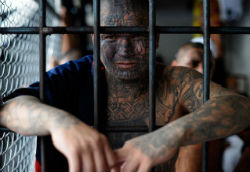A new report reveals the presence of street gangs or “maras” from the Northern Triangle in Costa Rica, while recent trends in the country’s criminal dynamics suggests the influence of the criminal groups in the “Switzerland of Central America” may expand.
According to Costa Rica’s Judicial Investigation Body (OIJ), members of the Barrio 18 and MS13 street gangs have maintained a presence in the country since the mid-2000s, reported Diario Extra. Costa Rican authorities have confirmed the arrests of 11 Barrio 18 and MS13 operatives over the past decade in various parts of the country (see Diario Extra’s map below).
 An MS13 member identified only as Paz told Diario Extra he has been living in Costa Rica since 2008. Although Paz is currently serving a 25 year prison term in a Costa Rican prison for drug trafficking and kidnapping, he said he has no interest in eventually moving back to San Salvador, his birth place.
An MS13 member identified only as Paz told Diario Extra he has been living in Costa Rica since 2008. Although Paz is currently serving a 25 year prison term in a Costa Rican prison for drug trafficking and kidnapping, he said he has no interest in eventually moving back to San Salvador, his birth place.
“I had a distributor and a restaurant in Ciudad Neily [a city in southern Costa Rica]. In my country [El Salvador] I can’t have anything because I belong to a street gang, and I couldn’t permit my children to die of hunger,” Paz said.
Central America’s Northern Triangle (El Salvador, Guatemala, Honduras) is the main base of operations for both street gangs, or “maras,” with El Salvador being their spiritual headquarters. However, the Barrio 18 and MS13 are known to have a presence in cities throughout the isthmus, as well as Mexico and the United States.
InSight Crime Analysis
Maras have never had a significant presence in Costa Rica, which has undoubtedly helped the country avoid much of the endemic violence that has plagued the Northern Triangle. In 2014, Costa Rica registered a murder rate of 9.5 per 100,000; three times lower than any Northern Triangle country and a far cry from El Salvador and Honduras, which both recorded a homicide rate of over 60 per 100,000. In fact, Costa Rica has become known as the “Switzerland of Central America” in part due to its stellar security reputation.
However, there has been increasing evidence Costa Rica may no longer deserve that title. Mexican transnational criminal organizations have been active in Costa Rica for years, but it appears their presence is now beginning to the spur the growth of well-armed local gangs. The country’s increased importance as a transit point in the transnational drug trade has also likely driven illicit drug consumption; a 2012 report by the Organization of American States (OAS) found Costa Rica’s per capita cocaine use is double that of Brazil, the world’s second largest consumer market. Meanwhile, authorities attributed the uptick in violence last year to gangs battling for control of the local drug trade.
SEE ALSO: Coverage of Costa Rica
Increasingly profitable domestic drug markets are one pull factor that could attract the maras to Costa Rica. The susceptibility of the judicial system to organized crime is another element that could enable the maras to operate relatively unmolested in Costa Rica. Costa Rica does not have a history of Mano Dura (“Iron Fist”) security policies that have been used in the Northern Triangle to target gangs. El Salvador’s aggressive anti-gang policies have reportedly resulted in the migration of some gang members to neighboring Honduras and Guatemala. As violence continues to spiral out of control in El Salvador, maras may be looking further afield for places to relocate, and Costa Rica could be a choice landing spot.

